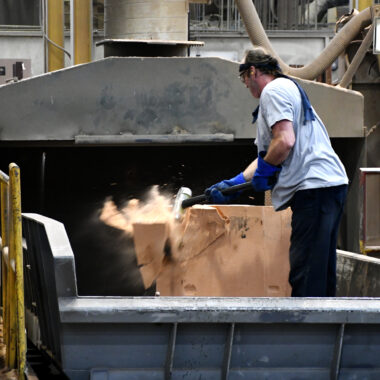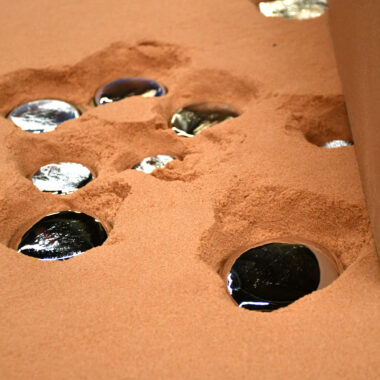Experience Superior Aluminum Casting Illinois: Your Relied On Partner
Experience Superior Aluminum Casting Illinois: Your Relied On Partner
Blog Article
Understanding the Craft: Specialist Tips for Flawless Aluminum Casting Results
In the realm of aluminum accuracy, expertise and casting are paramount to achieve impeccable results. Understanding the craft requires a meticulous understanding of the tools and devices at one's disposal, an eager eye for preparing the light weight aluminum alloy to specific specs, and an ingenious hand in utilizing optimal casting techniques.
Necessary Devices and Equipment
Light weight aluminum spreading requires particular devices and tools to guarantee precision and performance while doing so. Important devices consist of a crucible, mold and mildew, furnace, and ladle. The crucible, normally constructed from graphite or ceramic materials, stands up to heats needed to thaw light weight aluminum. A well-insulated heating system capable of getting to temperature levels over 1200 ° C is necessary to dissolve the steel. The mold, typically constructed from steel or sand, shapes the molten aluminum right into the wanted form. A ladle is utilized to move the fluid metal from the crucible to the mold without spillage.
Additionally, devices like tongs, handwear covers, and aprons are essential to guarantee the safety of drivers working with liquified aluminum. Spending in premium tools and devices not only boosts the accuracy of light weight aluminum casting yet also contributes to an extra secure and effective production procedure.
Preparing the Light Weight Aluminum Alloy
To make certain the success of the light weight aluminum spreading process, careful preparation of the alloy is vital. The primary step in preparing the light weight aluminum alloy is to very carefully pick the suitable kind of aluminum based on the attributes required for the end product. Aspects such as strength, rust resistance, and machinability require to be considered when selecting the alloy. As soon as the alloy type is figured out, it is vital to effectively clean up the light weight aluminum to eliminate any type of impurities that can impact the casting quality. This can be done via techniques like degassing, filtering, and fluxing.
After cleaning, the next vital step is to heat up the aluminum to the suitable temperature for casting. This procedure, called alloy melting, makes sure that the aluminum is in its molten kind and all set for spreading (aluminum casting illinois). Furthermore, managing the temperature throughout melting is essential to stop getting too hot or underheating, which can cause problems in the end product. In general, precise preparation of the light weight aluminum alloy sets the foundation for an effective spreading procedure and high-grade end outcomes.
Optimum Casting Methods
Implementing specific casting techniques is necessary for accomplishing high-quality outcomes in light weight aluminum casting procedures. One critical technique is making certain correct mold and mildew prep work. This involves precise cleaning and layer of the mold and mildew to stop light weight aluminum from sticking and ensure smooth spreading. In addition, managing the putting temperature level is important. The light weight aluminum should be heated up to the optimum temperature to minimize defects like shrinking and porosity in the final actors.
Moreover, maintaining constant pouring speed and stress is crucial to attaining uniformity in the actors item. Consistent and slow-moving pouring aids protect against turbulence and air entrapment, which can result in flaws. Another vital facet is using degassing representatives to remove impurities and gases from the molten aluminum, resulting in a cleaner last item.

Achieving Smooth Surface Area Finishes
For makers from this source seeking to enhance the visual pop over here appeal and quality of their light weight aluminum castings, achieving smooth surface area finishes is an essential facet complying with specific spreading methods and appropriate air conditioning treatments. One secret technique to attain smooth surface coatings is by making use of high-quality mold and mildews that are appropriately prepared and kept. The mold surface should be diligently cleansed and coated with release representatives to protect against imperfections moving onto the actors aluminum throughout the cooling process.
Furthermore, controlling the air conditioning rate of the aluminum spreading is critical for attaining a smooth surface area finish. Rapid air conditioning can cause thermal gradients that lead to appear problems, while slow air conditioning may create microstructural problems - aluminum casting illinois. By executing controlled air conditioning processes, such as making use of air or water quenching techniques, makers can make sure that the aluminum strengthens evenly, minimizing the probability of surface imperfections
Along with mold and mildew top quality and cooling down treatments, post-casting therapies like shot blasting or chemical etching can better refine the surface area coating of light weight aluminum castings. These techniques aid smooth out any remaining roughness or pollutants, leading to a perfect look that satisfies the finest quality standards.
High Quality Control and Troubleshooting

In the world of troubleshooting, it is necessary to have an extensive understanding of typical problems that can occur during aluminum casting, such as shrinkage, porosity, or surface area abnormalities. Constant enhancement through quality control and fixing practices is fundamental to accomplishing flawless results in aluminum spreading.
Final Thought
To conclude, understanding the craft of light weight aluminum spreading visit this site right here requires important tools and tools, proper preparation of the light weight aluminum alloy, ideal casting techniques, attaining smooth surface area coatings, and implementing quality assurance procedures. By adhering to these expert ideas, remarkable results can be attained in aluminum casting processes. Quality assurance and troubleshooting are necessary aspects to consider to guarantee consistent and high-quality results in aluminum casting tasks.
The initial action in preparing the aluminum alloy is to thoroughly pick the proper type of light weight aluminum based on the characteristics required for the last item.Carrying out specific spreading strategies is important for attaining top notch results in light weight aluminum casting procedures. By grasping these optimal spreading techniques, manufacturers can continually create flawless light weight aluminum spreadings.
For suppliers seeking to enhance the visual allure and high quality of their aluminum castings, accomplishing smooth surface finishes is a vital aspect following accurate casting methods and appropriate air conditioning procedures.In verdict, mastering the craft of light weight aluminum casting calls for important tools and devices, proper prep work of the aluminum alloy, optimal casting techniques, achieving smooth surface area coatings, and implementing top quality control measures.
Report this page